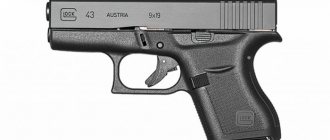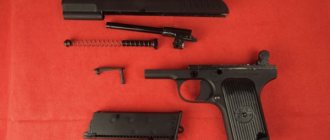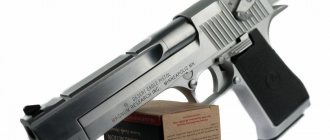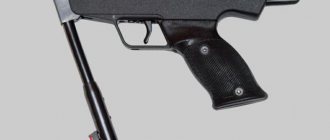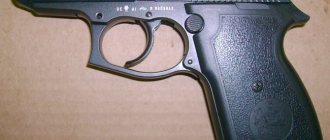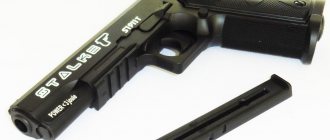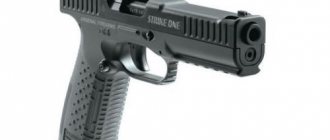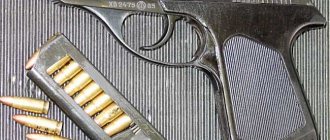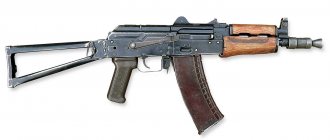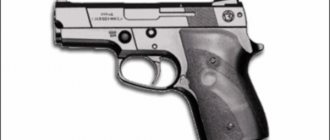Description of the airsoft pistol WE Glock 23 Gen 4 Chrome (6.0 mm)
A high-quality airsoft version of the Austrian Glock 23 pistol from the largest Taiwanese manufacturer WE will undoubtedly attract the attention of many airsoft fans.
BE drive Glock 23 Gen 4 Chrome looks simply gorgeous and the first thing that catches your eye is the chrome-plated bolt casing. The WE Glock 23 Gen 4 Chrome Airsoft Pistol comes in a printed cardboard box. The delivery set includes the drive itself, a magazine, replaceable handle pads and 6 mm plastic balls.
And, despite this, the price of the BE Glock 23 Gen 4 Chrome pistol will be a pleasant surprise for many shooting enthusiasts.
Plastic balls act as the main ammunition for firing a shot. To load them, a mechanical magazine with 24 rounds of ammunition is used. When leaving the barrel, the speed of the ball is about 90 m/s.
This is facilitated by muzzle energy of up to 3 J, as well as a liquefied mixture - green gas. The refill bottle must be purchased separately. The gas compartment is located inside the mechanical magazine and when fully filled, more than 40 shots can be fired.
The only downside is that at temperatures below 10 degrees Celsius, shooting from the airsoft WE Glock 23 Gen 4 Chrome will be impossible.
The manufacturer also recommends not using other liquefied mixtures, especially carbon dioxide, as energy. This can lead to failure of the main mechanisms of the weapon.
The body of the BE Glock 23 Gen 4 Chrome pistol is made mainly of light alloy steel and plastic. Plastic elements are the frame and pistol grip of the model.
Thanks to the presence of the Blowback system, the shooter does not have to jerk the bolt with each shot. It will be necessary to perform such an action only before the first pull of the trigger. In the future, when moving backwards, the shutter will automatically cock the trigger.
Two fuses will ensure complete safety against an accidental shot.
The standard sighting devices of the BE Glock 23 Gen 4 Chrome airsoft pistol are the front sight and rear sight. Also, if you really want, you can install a flashlight or laser laser on a Picatinny .
Buying an airsoft WE Glock 23 Gen 4 Chrome is worth it to all participants in airsoft competitions, as well as people who are interested in weapons of this type.
Description of the airsoft pistol KJW Glock G18 Tan (6.0 mm)
A modern gas-type airsoft model from the large Taiwanese manufacturer KJW is suitable not only for playing airsoft, but also for entertaining target shooting.
The airsoft KJW Glock G18 Tan exactly copies the Austrian-made Glock 18 pistol. The word Tan in the model name indicates that the KJW Glock G18 Tan pistol has an unusual sand color. This makes it stand out even more among the variety of airsoft weapons.
At the same time, the price of the KZhV Glock G18 Tan airsoft pistol will be a pleasant surprise for many skeptical buyers.
Light alloy metal is predominantly used in the production of the case of this model. However, there are also elements made of impact-resistant plastic. These elements are the sights, the magazine heel and the frame.
Thanks to the use of these materials, it was possible to achieve a relatively low weight of the structure. With a length of 190 mm, the weight of the model does not exceed 780 grams.
The main driving force of the KJW Glock G18 Tan pistol is green gas. Refilling is carried out through a small groove at the bottom of the magazine. It is worth noting that this gas is slightly inferior in power to CO2.
However, this will be quite enough to participate in airsoft competitions. The model is multi-charged and about 25 balls can be loaded simultaneously into a special magazine.
The balls are made of plastic and have a caliber of 6 mm. The initial speed after pressing the trigger reaches 90-100 m/s.
Firing from the KZhV Glock G18 Tan drive is carried out in semi-automatic mode. To fire the first shot, you will have to jerk the shutter. However, with subsequent shots, the trigger will be cocked automatically. This was facilitated by the Blowback system.
To adjust the hop-up, you need to disconnect the shutter housing from the frame. At its lower part there is a small relief wheel. By scrolling it you can reduce or increase the degree of twist of the ball.
Safety during operation of the KJW Glock G18 Tan airsoft is maintained thanks to two fuses - automatic and mechanical. The mechanical fuse is located at the bottom of the frame and is designed as a switch with a model number.
An automatic safety button in the form of a button is integrated into the trigger. With their help, the shooter will not be able to fire an unintentional shot.
Sights are open type - front sight and rear sight. Picatinny rail at the bottom of the barrel . Using this bracket you can install a flashlight or laser pointer.
It is worth noting that you can buy a KJW Glock G18 Tan pistol in our online store without a special license.
Description of the airsoft pistol KJW G27 MS ODG (6.0 mm)
All airsoft fans spend a lot of time choosing the best model for participation in competitions.
The KZhV G27 MS ODG drive from the Taiwanese company KJW is distinguished by its compact size and impressive power. A distinctive feature of this model is its complete resemblance to the Austrian Glock 27 pistol. The body of the KJW G27 MS ODG pistol is made of high-quality light alloy metal and impact-resistant polymer. The magazine and bolt casing are made of metal.
The remaining elements are made of plastic. Thanks to this material, the manufacturer managed to reduce the total weight of the weapon to 0.5 kg. The length of the model does not exceed 160 mm.
Buying an airsoft pistol KZHV G27 MS ODG is recommended for all shooting enthusiasts, from beginners to professionals.
The model is multi-shot and 14 shells can be loaded into a special magazine at once. Plastic balls with a diameter of 6 mm are used as projectiles. The initial speed of the ball when leaving a smooth barrel is about 90 m/s.
The power of this model is low and this is done so as not to cause damage to people while playing airsoft. Also, to protect against an unplanned shot, the KJW G27 MS ODG pistol is equipped with two fuses.
The automatic safety is integrated into the trigger, and the mechanical safety is located at the bottom of the barrel. With their help, the owner of the airsoft KZHV G27 MS ODG can be completely confident in his safety.
Before the first shot, the user must tighten the bolt housing. On subsequent shots, the bolt will automatically cock the trigger mechanism.
Another feature is the ability to adjust the ball twist. To access the adjustment drum, you need to separate the shutter housing from the frame.
Reliable sighting devices are required to make an accurate shot. The KJW G27 MS ODG airsoft pistol is designed with a front sight and a rear sight. They are perfect for firing from close to medium range.
And although the model is manufactured in Taiwan, the price of the KZhV G27 MS ODT pistol will pleasantly please many buyers with its affordability.
The model is also perfect as an additional weapon for shooting in confined spaces.
Glock pistols (Austria)
In 1963, Gaston Glock, a little-known engineer at that time, specializing in the construction of machine tools, founded a company near Vienna. In the mid-70s. XX century he developed a pistol of his own design, the automation of which worked according to the classic Browning scheme due to the recoil of the barrel with a short stroke.
In 1980, representatives of the Austrian military department announced a competition for the best model of an army pistol. took part in it, presenting a modernized pistol designed to use 9x19 “Parabellum” cartridges.
The main distinguishing feature of this weapon was the widespread use of composite materials in its production. The receiver and frame of the pistol were entirely made of high-strength polymer material that could withstand ambient temperatures from –40 to +200 °C. At the same time, 80% of the pistol was made of metal, so the assertion that it is invisible under X-ray control and is therefore in demand among terrorists has no basis. During testing, the pistol showed good firing characteristics and, according to experts, was highly reliable and safe.
The latter was achieved due to the automatic fuse used in its design, which was located on the trigger spoke and blocked the trigger rod and the firing pin. The pistol was fired only when the trigger was pressed correctly, which eliminated the possibility of an unintentional shot. Additional safety was provided by a hammerless trigger mechanism of the so-called safe action with 3 automatic fuses (including those located on the trigger). A special feature of this mechanism is that during the reloading cycle of the pistol, the firing pin is only partially cocked, while it is blocked using an automatic safety device. The firing pin is re-cocked only when the trigger is pressed. This makes it possible to achieve a constant force on the trigger from the first to the last shot, which has a positive effect on shooting accuracy.
True, during the operation of Glock pistols, there were shooters who were dissatisfied with this design. Claims about its shortcomings were somewhat far-fetched. For example, they noted the impossibility of re-firing a cartridge that misfired, as well as the increasing incidence of injuries among American police officers. It turned out that, accustomed to pistols equipped with mechanical safeties, they often tried to holster their Glock without removing their finger from the trigger. In this case, the finger would hit the edge of the holster, turn off the automatic safety, and the policeman would shoot himself in the leg. Objectively, this question arose more due to a lack of skills and did not point out the shortcomings of the pistol.
In addition to increased safety, the pistol differed from its competitors in its simplicity of design. It consisted of only 33 parts, including the magazine, and, if necessary, could be easily disassembled and assembled using one screwdriver (in a pinch, it could be replaced with a simple nail).
The use of new technologies and the originality of the pistol design made it possible to formulate a price that was 25% lower than that of its closest competitors. This, along with high reliability, predetermined victory in the competition. In 1983, the pistol, which received 17 (the number indicated the magazine capacity), was adopted by the Austrian army under the name P 80. This marked the beginning of worldwide recognition of the product. The very next year, in October 1984, pistols began their offensive on the American market and within one decade practically captured it. An example of this is the fact that more than 5,000 local and federal police departments have adopted or authorized the use of Glock pistols as duty weapons. At the end of the twentieth century. already more than 60% of pistols exported to America, intended for arming police officers, were branded “Glock”. In addition, Austrian pistols were adopted by police departments and army units in more than three dozen countries around the world.
The perfection of the Glock 17 design allowed the company's engineers to use it as the base model for a whole series of pistols. Subsequently, the family of pistols bearing this brand developed mainly only due to changes in the caliber, magazine capacity and overall dimensions in the base model. An exception may be the 9 mm Glock 18 pistol, equipped with a fire type translator. Magazines with a capacity of 33 rounds were produced especially for this model, which allows for fairly effective shooting in automatic mode at short distances. At the same time, the theoretical rate of fire of the pistol reached 1200 rounds/min.
Read: Pistol VIS 35 (Poland)
In parallel with the development of an automatic pistol, specialists released a civilian version of the Glock 17 pistol with the index “L”. The main purpose of this 9 mm pistol was sports shooting, so it received an increased aiming line by lengthening the pistol by 39 mm. The next pistol was the compact model No. 19. Compared to the base pistol, this pistol lost 12 mm in length, 11 mm in height, and 30 g in weight. This allowed it to find fans not only in the army and police, but also among the civilian population Europe. In 1988, Glock 19 pistols began arriving in the United States and, despite the fact that they were still designed to use the 9-19 Parabellum cartridge, quickly gained popularity
At the end of the 80s. XX century It became obvious that further expansion of the Glock pistol model range should follow two main paths - changing the dimensions of the pistol and increasing the caliber of the cartridges used in it. The most fruitful year for the company was 1990. In July, the Glock 20 pistol was introduced, retaining the dimensions of the base model and designed to use the 1025 Auto cartridge. A few months earlier, it released two pistols chambered for the .40 Smith & Wesson cartridge (10 mm): the standard model No. 22 and the compact model No. 23. In terms of overall dimensions, these pistols were exactly the same as models No. 17 and No. 19. In mid-1990. The Glock 17 L was converted to the .40 Smith & Wesson cartridge, and the new sporting pistol was given the name Model No. 24. At the end of the year, sports shooting enthusiasts received another model of the Glock brand at their disposal. This pistol has basic dimensions, but was designed to use powerful .45 ACP (11.43 mm) cartridges. Many of the listed models were equipped with compensators - milled slots on the barrel and bolt, which served to reduce the “toss up” of the muzzle when fired. Such pistols had the Latin letter “C” in their designation after the model number.
The second modeling boom did not occur in 1995. The expectations of fans were not deceived. Initially, the Glock 25 pistol was released, in size it belongs to the Compact class (similar to models No. 19 and No. 23), but was designed to use the .380 “Auto” cartridge. This pistol became very popular in Europe, but never appeared on US markets due to restrictions on imported weapons.
However, the real surprise for pistol lovers lay ahead. Following model No. 25, miniature Subcompact class pistols began to go on commercial sale - Glock 26 and Glock 27. The first of them was designed to use the Parabellum cartridge of the European 9x19 mm caliber, the second - the American .40 Smith & Wesson.
The length of the new class of pistols was as much as 26 mm less than that of the base model No. 17, the height was 32 mm, the weight with a loaded magazine was reduced by 142 g. It was difficult to even imagine any other weapon more suitable for concealed carry and sudden applications than these miniature plastic pistols. At the same time, the high safety, combat qualities, reliability, and ease of use characteristic of weapons were not affected at all when minimized. The only drawback of “Subcompact” class pistols can be considered a shortened handle, however, according to experts, after a few minutes the shooter’s hand gets used to the lack of space for the little finger, and holding the weapon does not present any difficulties. Otherwise, those who shot from pocket pistols made the most favorable impressions of it: the pistol is comfortable to use, easy to control, and the recoil, thanks to the successful tilt of the handle, is directed strictly into the palm and is perceived in the same way as with pistols of more respectable classes. As predicted, the company was immediately inundated with orders for subcompact pistols from police and civilians. This allowed the company’s specialists to even release a specialized version of the .380 “Auto” pistol and was intended for sale only in South America, where in many countries the civilian population is prohibited from having weapons chambered for so-called military cartridges.
Read: FN P90 submachine gun
In January 1997, specialists began production of two more new “Subcompact” class pistols. They were model No. 29, designed to use the 10x25 “Auto” cartridge, and model No. 30, long-awaited for American gun fans, chambered for the .45 ACP caliber cartridge. In almost all overall dimensions, these pistols corresponded to the pocket Glock 26 and Glock 27, however, the use of more powerful cartridges in them for firing made some adjustments. Designed to handle the higher pressures generated by 10×25 Auto and .45 ACP cartridges, their bolts are slightly longer and wider. This inevitably entailed an extension of the frame, but did not affect the size and shape of the handle. It was possible to maintain its dimensions due to a completely justified reduction in the number of cartridges.
The Glock 29 pistol magazine has a capacity of 10 rounds, and the standard magazine for the Glock 30 has a capacity of 9 rounds. If desired, it can use a 10-round magazine, but it will protrude somewhat from the handle. Despite this inconvenience, high-capacity magazines are used quite often, and this forced specialists to promise to soon release a 10-round magazine that does not protrude beyond the handle. Theoretically, the Glock 29 pistol can be powered by a 15-round magazine from model No. 20 (similarly, for the Glock 30 - a 13-round magazine from model No. 21), however, manufacturers recommend using such a replacement only in extreme cases. The shortened handle “provokes” the shooter to use the part of the magazine protruding from the frame as its extension. According to experts, this can lead to delays in feeding ammunition, as happens on a submachine gun when it is held in this way.
Like all previous models, the Glock 29 and Glock 30 were equipped with fixed plastic sights. If desired, a non-adjustable self-luminous or vertically and horizontally adjustable sight could be installed on the purchased pistol (primarily this concerned sports models).
In subsequent years, specialists mastered the production of pistols designed to use a cartridge developed by the Swiss company SIG of .357 caliber (made on the basis of a cartridge case from the .40 Smith & Wesson cartridge, the barrel of which is compressed for a 9 mm caliber bullet). Moreover, each of the main classes of the Glock model range was represented by its own pistol: “Standard” - “Glock” 31, “Compact” - “Glock” 32, “Subcompact” - “Glock” 33.
At the end of the twentieth century. the model range already consisted of 20 units (not counting the models on which the compensator was installed). In many ways, the growing popularity of each new model of the Glock pistol, in addition to objective indicators, was facilitated by well-planned advertising. The best example of this is the widely publicized ability of Glock pistols to fire underwater (for this, a special recoil spring is installed on the pistol). It is unlikely that anyone will take advantage of this opportunity, since shooting can only be carried out at a depth of several meters and over a short distance. However, this fact is the best possible indication of the high strength of the structure and demonstrates the ability to use the weapon, for example, in the rain, in the presence of water in the barrel, which in other pistols can lead to swelling or even rupture of the barrel. The high strength and reliability of the design of Glok pistols is also evidenced by the fact often found in the press that they can withstand up to 360,000 shots, while only 40,000 shots can be fired from a considered good army pistol. Therefore, it is not surprising that pistols enjoy well-deserved popularity all over the world, and in America they even almost eclipse the former glory of the products.
Read: Degtyarev submachine guns PPD-34 and PPD-40
DESIGN OF GLOCK PISTOLS
The automatic operation of Glock pistols works by using the recoil energy of the barrel during its short stroke. The barrel bore is locked by connecting the rectangular profile of its breech to the bolt, which engages with the window for ejecting cartridges. The shutter is made of steel using high-precision casting and is subjected to special treatment to increase corrosion and wear resistance.
Glock is one of the first pistols in the design of which composites and plastics began to be actively used. The receiver and frame of the pistol are made of impact-resistant plastic.
All Glock brand pistols are equipped with box magazines with a double-row arrangement of cartridges and their exit in one row. Magazine bodies, feeders and covers are made of plastic. At the same time, the body is additionally reinforced with steel inserts and has holes to control the fullness of the magazine, which start from the fourth cartridge and end opposite the last one.
The handle of the Glock 27 pistol has an anti-slip rough surface and a thumb rest on both sides, and its rear wall has a notch. To increase the reliability of gripping the handle, there are two depressions for the fingers on the front wall, since with normal hand sizes the little finger does not fit on the shortened frame. The space between the cavities for the fingers on the front surface of the handle is equipped with a notch. Early models of pistols have grips with flat “cheeks” and grooved front and rear surfaces. Pistols of later releases have grooves for fingers on the front side of the grip and small “shelves” for the thumb on the sides. The shape of the handle and its angle of inclination ensure a reliable hold of the weapon during shooting for people with any hand size.
The trigger mechanism of a hammerless pistol. The firing pin is in the half-cocked position whenever the pistol is ready to fire. Shooting is carried out by self-cocking. The trigger force can be adjusted within 2–5 kgf by replacing the spring.
The pistol has an automatic safety (located on the trigger spoke), a blocking striker and a trigger rod. To prevent accidental discharge, the safety is equipped with three internal locking mechanisms. When the trigger is pressed, these locking mechanisms are turned off, the firing pin is cocked and released to fire a shot. After each shot, the pistol is automatically put on safety until the next pull of the trigger.
The sight is open, non-adjustable, zeroed at 50 m. It is possible to install a sight adjustable horizontally and vertically. On the frame of Standard and Compact class pistols, under the barrel there are guides for attaching a laser target designator or combat flashlight. The pistol's firing pin has a rectangular cross-section and a wedge-shaped firing pin. Although the primers leave a characteristic, recognizable mark from the striker, with this unusual design of the striker, the primer provides less resistance to the striker (which reduces the likelihood of the striker breaking), and the impulse of the striker is concentrated on a smaller area, which ensures reliable ignition.
You might be interested:
- Pistol 6P35 "Grach"/SPS
- Pistol GSh-18
- Design of the Heckler & Koch P 2000 pistol
- PSS pistol design
- Glock 17 pistol
- Design of the Walther P 99 pistol
Subscribe to
our channel in Yandex.Zen
